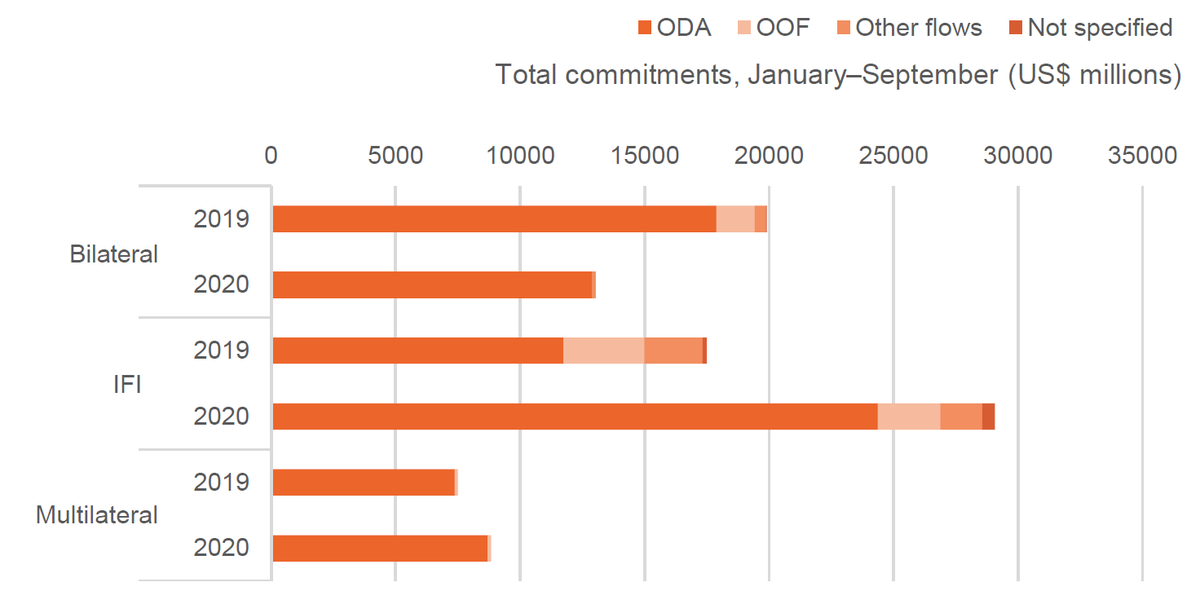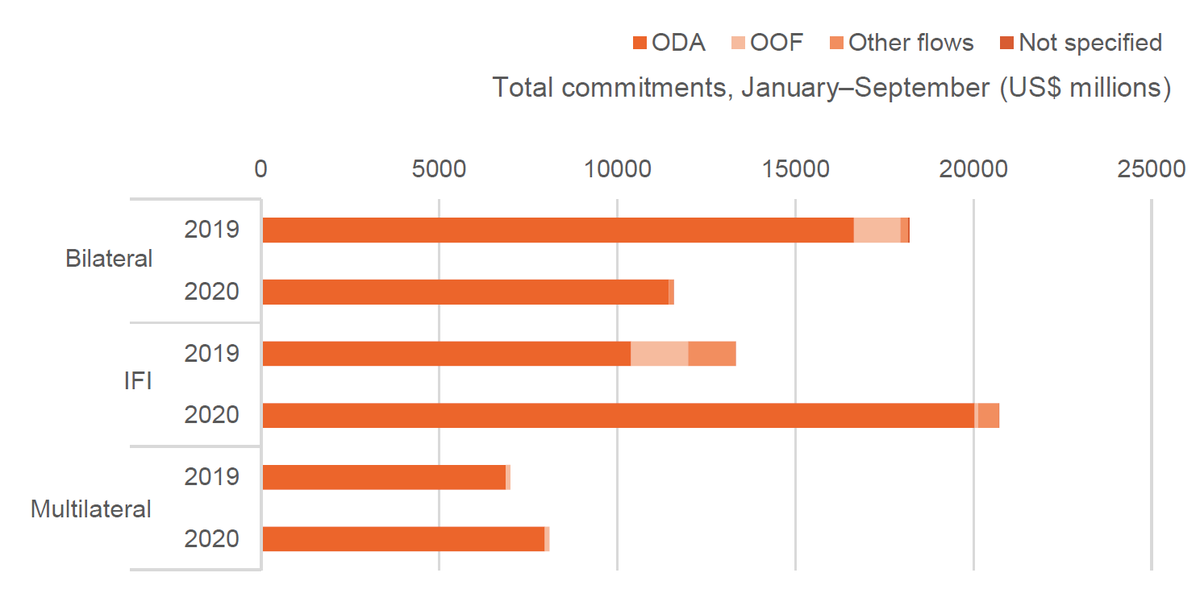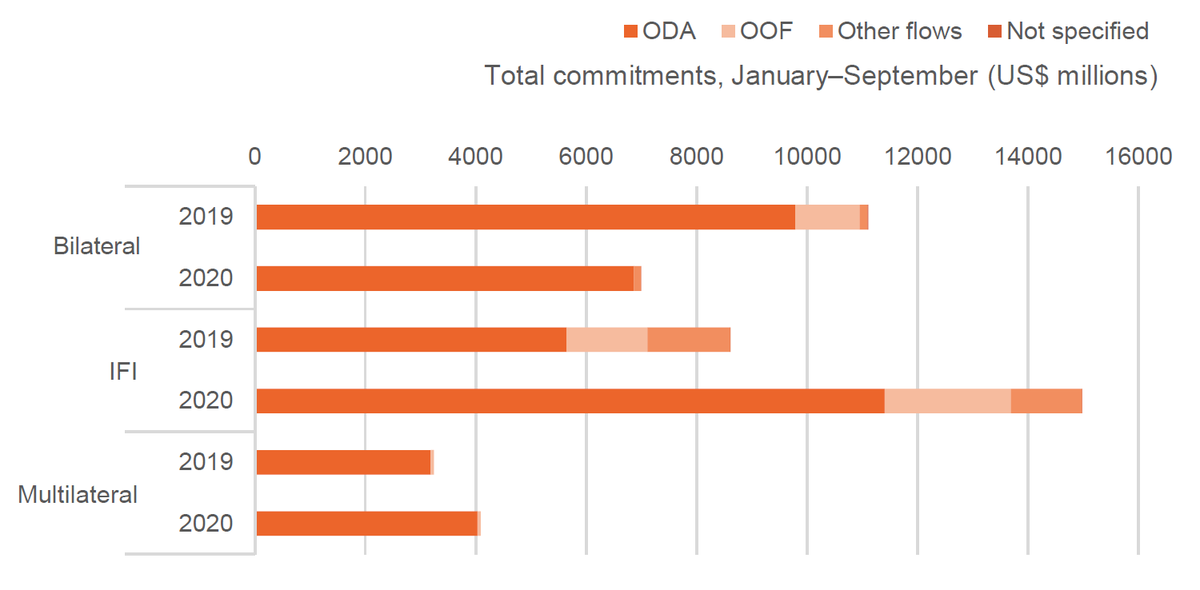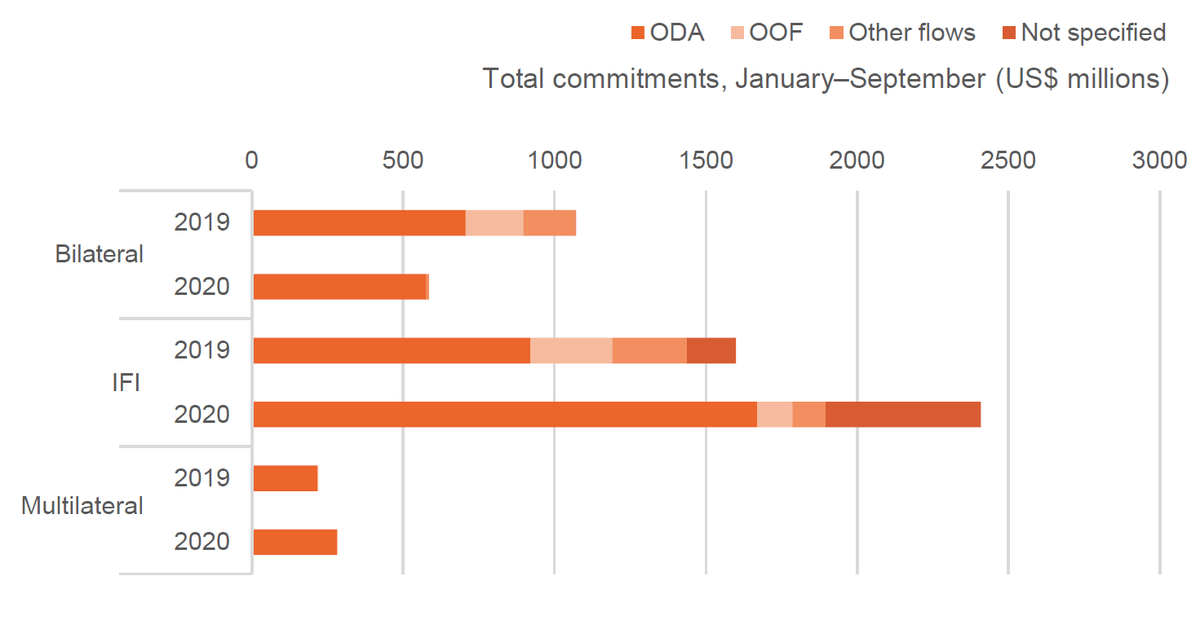Aid to LDCs, LLDCs and SIDS during the Covid-19 pandemic
Find out what near real-time data shows about trends for aid to the least developed countries (LDCs), landlocked developing countries (LLDCs) and small island developing states (SIDSs) during the Covid-19 pandemic.
DownloadsIntroduction
As we enter 2021, focus is increasingly turning to the challenges we will be facing this year as we seek to address the devastating economic and social crises caused by the Covid-19 pandemic. There is little doubt that some countries and some people have been worse affected than others and will continue to feel the effects for a long time. This is especially true for the least developed countries (LDCs) whose resilience to crises and shocks was already constrained, landlocked developing countries (LLDCs) who face challenges associated with remoteness and high transportation costs, and small island developing states (SIDS) who are already challenged by the climate crisis.
Financing any crisis response is always difficult – and for those countries facing the greatest impacts from the Covid-19 pandemic aid will be a vital part of enabling a sustainable and long-term response . Domestic resources in developing countries have been (and will continue to be) hit hard by the effects of the pandemic, with our predictions indicating that these countries will see a fall of over US$2.2 trillion in the next two years. [1] Levels of debt are also a serious and growing concern. For example, in LDCs gross government debt had already climbed from 39% of GDP in 2008 to over 52% in 2018. [2]
Global, real-time trends in aid during the Covid-19 pandemic show that bilateral aid commitments have been falling (down 40% for January to September 2020 as compared to the same period in 2019; with official development assistance, ODA, alone falling 26%) while there has been a significant uptick in financing from international financial institutions (IFIs) (34% increase in aid commitments; with a 162% increase in ODA commitments, largely in the form of loans).
Development Initiatives will be updating our tracker showing aid flows in light of the Covid-19 crisis each month. This factsheet seeks to delve deeper into these trends and assesses the changes we are seeing right now for those countries facing particular challenges and constraints. The factsheet looks at near real-time aid trends for LDCs, LLDCs and SIDS, from January to September 2020 compared to the same period in 2019.
Key findings
For LDCs, LLDCs and SIDS as a whole
-
Across LDCs, LLDCs and SIDS as a whole, aid from bilateral donors is down 35%
– tracking the same direction of travel seen in global analysis for this year to date, which saw bilateral aid commitments fall by 40% (comparing January to September in 2019 and 2020). This includes a particularly important drop of 28% and US$5.0 billion in ODA (26% globally).
- For bilateral donors, the drop in aid commitments to LDCs is the most significant in volume terms at US$6.6 billion and thus the largest driver of the downward trend.
-
For LDCs, LLDCs and SIDS as a whole, aid commitments from IFIs have increased significantly, by 66%
(comparing January to September in 2019 and 2020). The rate of increase is almost double those seen at the global level, where they have increased by 34%. Of total IFI commitments to this group, 84% (US$24.4 billion) is now in the form of ODA, a 108% increase in ODA commitments from 2019.
- For IFIs, the increase to LDCs has been the largest driver of the change at almost US$7.4 billion, but the increase in commitments to LLDCs was also very significant at over US$6.4 billion.
- Data for multilateral organisations is sparse, so trend data is hard to extrapolate , but from the limited data available commitments show a relatively small increase of 18%.
- Bilateral donors remain important donors in LDCs and LLDCs, particularly as providers of grant finance. IFIs are much more important in SIDS.
By country grouping
Least developed countries
- In LDCs there has been a 36% drop in aid commitments from bilateral donors, whereas there has been a big uptick from IFIs (55%). Within this, ODA commitments from bilateral donors have fallen by 31%, while IFI ODA commitments have increased by 93%.
Landlocked developing countries
- In LLDCs there has been a similar drop in aid from bilateral donors of 37% and larger increase from IFIs of 74%. ODA commitments from bilateral donors have decreased by 30% while IFI ODA commitments have more than doubled, increasing by 102%.
Small island developing states
- In SIDS there has been a decrease of 45% in aid overall from bilateral donors. IFIs have substantially increased aid commitments, by 51%, including a big increase in ODA of 81%. Bilateral ODA commitments have decreased by 19%.
Box 1:
An important note about the data in this paper
In this factsheet, we use the term ‘aid’ as per its use in International Aid Transparency Initiative (IATI) data. In this context, aid incorporates all humanitarian and development assistance, including ODA (as defined by the OECD DAC ), other official flows (OOFs) and any other development flows reported by official actors to IATI.
- The factsheet does not cover all aid but rather looks at a range of key donors – bilateral donors, multilateral organisations and IFIs – which together comprise about 70% of all aid, and this gives us a strong indication of what is happening to aid in the context of the Covid-19 pandemic.
- It considers aid reported to date in the first nine months of 2020 (from January to September inclusive) and compares this to aid reported over the same period in 2019.
- It is primarily focused on commitments, which are more reflective of the decisions that donors are making today, in the context of the Covid-19 pandemic.
- As multiple donors may report on the same activity, analysis looks at bilateral donors, multilateral organisations and IFIs separately to avoid double counting issues while allowing for interesting comparison.
For more detailed information on coverage and approach see the detailed Methodology section of How is aid changing in the Covid-19 pandemic .
Trends in aid to LDCs, LLDCs and SIDS as a whole
Figure 1: Aid from bilateral donors is falling, while IFIs are playing an increasingly important role

Stacked bar chart showing aid from bilateral donors falling, while IFIs play an increasingly important role, between 2019 and 2020
Source: Development Initiatives based on IATI.
Notes: IFI = international financial institution; OOF = other official flows.
- IFI commitments to LDCs, LLDCs and SIDS are up quite significantly (66%), including an increase in ODA of 108% (US$12.6 billion) for the January to September period in 2020 compared to 2019. This is an important increase for these countries facing more challenging circumstances. The ODA increase is particularly important in both volume and proportion terms.
- Aid commitments from bilateral donors to these countries are down 25%, less than global bilateral aid commitments at 40%. As at the global level, there has been a significant fall in ODA to these countries from bilateral donors of 28% (US$5.0 billion).
- The data for multilateral organisations is relatively limited, but what data there is shows there has been a small increase in aid commitments of 18% (US$1.3 billion).
- These changes collectively mean that IFI aid commitments in these countries are now larger than those from bilateral donors – a key driver of this increase is the World Bank who have increased commitments by US$8 billion from 2019 to 2020.
Trends in aid to the least developed countries
Figure 2: Bilateral aid commitments to LDCs are falling, while aid commitments from IFIs are increasing substantially

Stacked bar chart showing bilateral aid commitments to LDCs falling, while aid commitments from IFIs increase substantially, between 2019 and 2020
Source: Development Initiatives based on IATI.
Notes: IFI = international financial institution; OOF = other official flows.
- There has been a significant drop in commitments to LDCs from bilateral donors (36%), while aid from IFIs has gone up (56%) – which is an important change to note as IFI commitments are more likely to be loans, and grants from bilateral donors are decreasing.
- Compared to trends in global bilateral aid commitments, which are down 40% compared to the same period last year, commitments to LDCs have dropped slightly less.
- IFI commitments have grown considerably more in LDCs than globally (34%).
- ODA from bilateral donors has gone down by 31% (US$5.2 billion).
- ODA from IFIs has gone up by 93% (US$9.6 billion).
Trends in aid to landlocked developing countries
Figure 3: Bilateral aid has also fallen to LLDCs, while IFIs are increasing aid commitments

Stacked bar chart showing bilateral aid to LLDCs has fallen, while IFIs increased aid commitments, between 2019 and 2020
Source: Development Initiatives based on IATI.
Notes: IFI = international financial institution; OOF = other official flows.
- As was the case for LDCs, there has been an important drop in commitments to LLDCs from bilateral donors – by 37% (US$4.1 billion) – while aid from IFIs has increased 74% (US$6.4 billion).
- Compared with bilateral aid commitments globally, which have declined by 40%, the drop in bilateral aid commitments to LLDCs has been slightly less.
- For IFI aid commitments, the changes in LLDCs have exceeded the global trend to date (34%).
- ODA from bilateral donors has gone down 30% (US$2.9 billion).
- ODA from IFIs has gone up 102% (US$5.8 billion).
Trends in aid to small island developing states
Figure 4: Bilateral aid commitments are dropping, while IFI commitments are increasing significantly

Stacked bar chart showing bilateral aid commitments dropped, while IFI commitments increased significantly, between 2019 and 2020
Source: Development Initiatives based on IATI.
Notes: IFI = international financial institution; OOF = other official flows.
- Unlike the situation for LLDCs and LDCs, IFIs are a relatively more important source of funding for SIDS, which is likely a reflection of the fact that more SIDS are high-income countries and upper-middle income countries, where IFIs generally have a more important presence. Compared to the same period last year, IFI aid to SIDS has jumped considerably, by 51%, while bilateral aid has decreased by 45%.
- In contrast to global trends in bilateral aid commitments (down 40%), those to SIDS have fallen slightly more.
- IFI aid commitments have, on the other hand, grown more than the change seen globally (34%).
- ODA from IFIs has gone up by 81% (US$748 million).
- ODA from bilateral donors has decreased by 19% (US$131 million).
Conclusion
Aid will play a vital part in an effective and equitable response to the health and economic crises caused by the Covid-19 pandemic. Ensuring those countries most in need of support are receiving sufficient resources is critical – and that is particularly true for LDCs, LLDCs and SIDS. And yet the current data points to a concerning trend. IFIs are stepping up support but this comes with some challenges, as it is likely to be primarily in the form of loans – which will raise questions around long-term debt sustainability – and the bulk of their historic focus has been on middle-income countries. This may also not be sustainable in the longer term as bilateral donors – a critical source of replenishment finance to IFIs and the multilateral system – are cutting commitments. Tracking aid data in real time shines a light on these challenges and gives us the opportunity to do something about them. As we enter a new year following the challenging year that was 2020, now is the time for us to reverse this concerning course and change track.
Notes
-
1
Development Initiatives, 2020. Adapting aid to end poverty: Delivering the commitment to leave no one behind in the context of Covid-19. Chapter 3. Available at: /resources/adapting-aid-to-end-poverty/covid-19-and-its-impact-financing-landscape/Return to source text
-
2
International Monetary Fund, October 2020. World Economic Outlook. Available at: https://www.imf.org/en/Publications/WEO/Issues/2020/09/30/world-economic-outlook-october-2020Return to source text
Related content
Tracking aid flows in light of the Covid-19 crisis
How is Covid-19 impacting aid flows? This data tool is updated monthly to track aid commitments and provide unique real-time analysis based on IATI data.
Tracking aid flows in light of the Covid-19 crisis
How is Covid-19 impacting aid flows? This data tool is updated monthly to track aid commitments and provide unique real-time analysis based on IATI data.
How is aid changing in the Covid-19 pandemic?
This briefing sets out near real-time data on aid for the first half of 2020. It shows how commitments are changing in the Covid-19 pandemic and where these are most likely to affect the poorest people and places.
How is aid changing in the Covid-19 pandemic?
This briefing sets out near real-time data on aid for the first half of 2020. It shows how commitments are changing in the Covid-19 pandemic and where these are most likely to affect the poorest people and places.
Adapting aid to end poverty: Delivering the commitment to leave no one behind in the context of Covid-19
This report calls for us to refocus ODA (aid) in the context of Covid-19, shifting the ‘leave no one behind’ agenda from inclusive growth to inclusive recovery. It analyses changes to poverty and how the pandemic has impacted finance vital to the poorest people.
Adapting aid to end poverty: Delivering the commitment to leave no one behind in the context of Covid-19
This report calls for us to refocus ODA (aid) in the context of Covid-19, shifting the ‘leave no one behind’ agenda from inclusive growth to inclusive recovery. It analyses changes to poverty and how the pandemic has impacted finance vital to the poorest people.